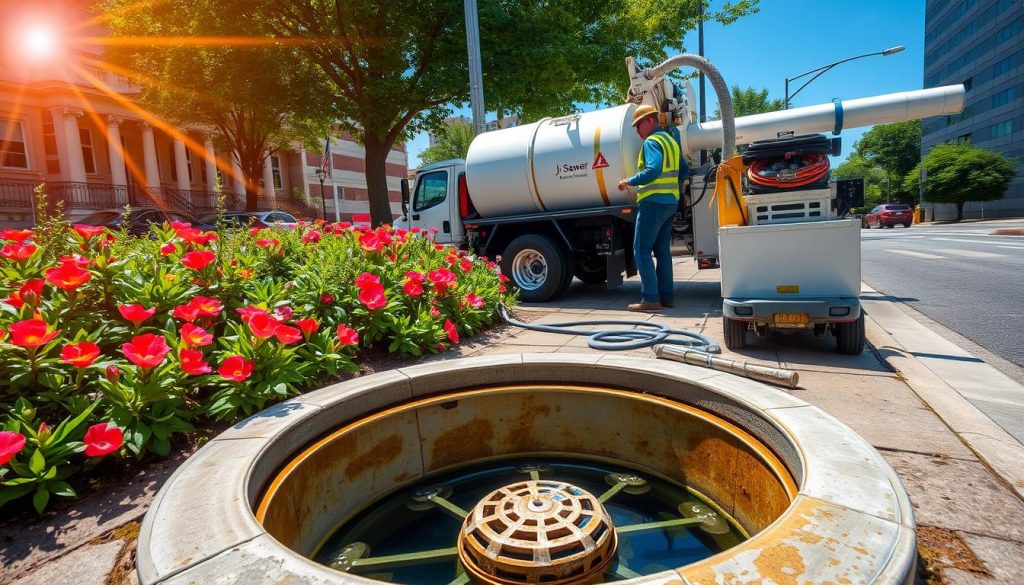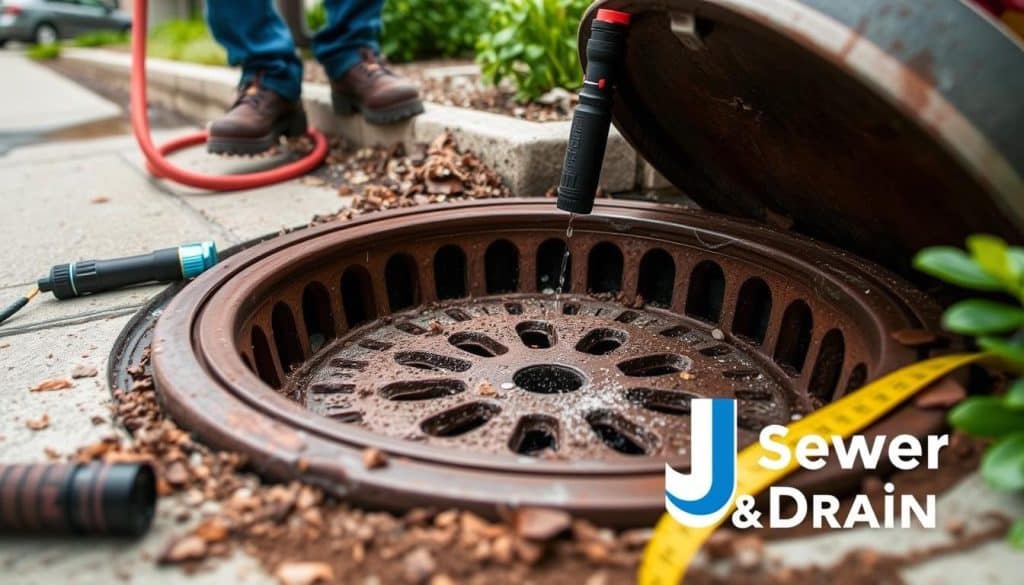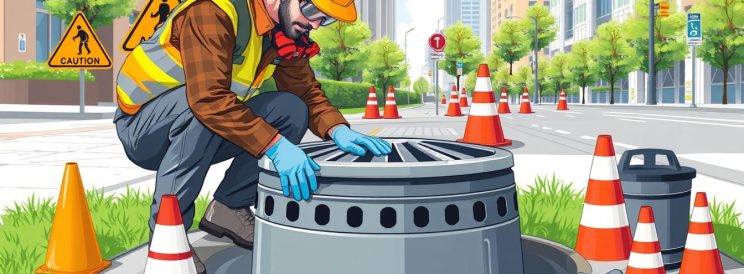Ever thought about How Often Should a Catch Basin Be Cleaned? It could lead to serious flooding and damage to your property. Catch basins, or storm drains, are key to keeping water away from your home. Knowing how often to clean them is crucial.
Catch basins catch debris and pollutants, keeping sewer lines clear. So, it’s important to have a regular cleaning schedule. Experts say you should clean them at least once or twice a year. This helps avoid backups and flooding, keeping your water system working right.
Key Takeaways
- Neglected catch basins can lead to severe flooding and property damage.
- Catch basins are essential components of a property’s water mitigation system.
- Routine cleaning prevents debris buildup and maintains efficient sewer lines.
- An optimal catch basin cleaning schedule should be followed at least once or twice yearly.
- Proactive maintenance practices help avoid backups and flow of contaminants into water streams.
- J Sewer & Drain Plumbing Inc. offers a 5-year guarantee on parts and labor for underground sewer repairs.
Understanding What a Catch Basin Is
A catch basin is key in managing stormwater runoff. It catches debris from yards or streets before it gets into sewer lines. These systems help keep properties safe and protect the environment by removing pollutants from stormwater.
It’s important to keep catch basins well-maintained. This helps prevent flooding and keeps our water systems safe.

Definition and Importance
Catch basins are crucial for managing stormwater runoff. They trap sediment, debris, and pollutants, stopping them from entering sewers and water bodies. They are found at street gutters or on private property.
Each catch basin has a grate, a sump for sediment, and an outlet pipe. This setup keeps floating debris and oils out, reducing pollution in rivers and streams. Keeping catch basins in good shape helps with drainage and supports local water life.
How Catch Basins Work
Catch basins work by guiding stormwater through a grated opening into a sump. Here, sediment and debris settle. Then, the water flows through an outlet pipe that keeps out floating debris and oils.
Regular maintenance is key. It involves cleaning the sump to remove sediment and debris. This keeps the system working well. It’s vital for managing stormwater runoff, preventing blockages that could cause flooding and harm the environment.
Signs That Your Catch Basin Needs Cleaning
Homeowners need to watch for signs that their catch basin needs cleaning. This is to avoid water damage and keep their drainage systems working well. Fixing problems early can prevent big damage and protect the environment.
Visual Indications
Looking for visual signs can tell you if your catch basin needs cleaning. Signs include blockages or overflow at the grate. Catch basins fill up fast with debris like leaves and trash.
If you see shiny spots, color changes, or strange stuff, call a pro like J Sewer & Drain Plumbing Inc. right away. These signs might mean there are harmful chemicals that need special care to follow local rules.
Performance Issues
Performance problems are another big clue that your catch basin needs a clean. Slow drainage or water pooling are signs you need to act fast. Debris buildup reduces the basin’s ability to work right.
Not taking care of these signs can harm your property and the environment. It’s important to follow best practices for cleaning catch basins to keep your system working well and safe for the planet.
The Optimal Catch Basin Cleaning Schedule
Choosing the right time to clean a catch basin depends on several things. These include how much stormwater it handles and what kind of debris it might get. Experts say cleaning catch basins once or twice a year is best. This keeps them working well and stops them from getting too full of sediment.
In places with lots of rain or where there’s a lot of debris, you might need to clean them more often. This is especially true for businesses and industrial areas.

For example, cleaning them every six months instead of once a year can really help. This way, you can remove more sediment and keep the basin working better. J Sewer & Drain Plumbing Inc. says it’s key to have a cleaning plan that fits your area’s weather, how you use the property, and other special needs.
To keep your catch basin in top shape, following cleaning tips and maintenance advice is important. By thinking about these things, you can take good care of your catch basins. This ensures they work well for a long time.
Best Practices for Routine Catch Basin Maintenance
Keeping catch basins in good shape is key to avoiding flooding and water damage. Regular cleaning helps your drainage system work better. It’s important to set a cleaning schedule for your catch basins.
Tools and Equipment Needed
You’ll need a few basic tools for catch basin upkeep: a strong shovel, heavy-duty trash bags, a pry bar, and tough gloves. Each tool has a specific role, from lifting grates to getting rid of debris. Good quality tools make the job easier and faster.
Step-by-Step Cleaning Process
Start by carefully taking off the grate with a pry bar. Then, pull out any visible trash and leaves by hand. Use a shovel to remove packed soil and hard-to-get debris from inside the basin.
Make sure to throw away all waste properly to keep it out of storm drains. If you face tough problems like tree roots or harmful substances, call experts like J Sewer & Drain Plumbing Inc.
Safety Precautions
Always put safety first when you’re cleaning. Be careful when removing the grate to avoid injuries. Never leave a catch basin open without someone watching.
Use the right safety measures if the basin is near a road. Also, think about using catch basin filter inserts and protecting against chemical spills. Regular sweeping can help you clean less often, making upkeep easier.


